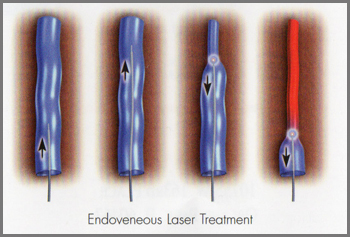Laser Ablation
Like radiofrequency ablation, a thin fiber is gently inserted through the skin and into the affected vein during the laser ablation procedure. This laser fiber heats the vein, causing it to close. After the fiber is removed and the healing process begins, the closed vein is reabsorbed into the body. The blood supply in that area is naturally rerouted through other, healthier veins.
When is laser ablation used?
Patients with large, symptomatic varicose veins and incompetent saphenous veins are candidates for laser ablation. This procedure is essentially taking the place of the antiquated “vein stripping” procedure. At Center for Vein Restoration, each patient is evaluated, and treatment is individualized for the patient’s unique circumstances.
What should I expect from laser ablation?
As a catheter procedure, there are four principal steps of laser ablation:
1. Mapping the saphenous vein
A typical procedure begins with comfortable, noninvasive ultrasound imaging of the varicose vein to trace its location. This allows our Center for Vein Restoration physician to determine where the ablation catheter will be inserted and mark the desired position of the catheter tip to begin treatment.
2. Inserting the laser fiber
Our physician then injects a volume of diluted anesthetic fluid into the area surrounding the vein. This numbs the leg, helps squeeze blood out of the vein, and provides a fluid layer outside the vein to protect surrounding tissue. Then, our physician accesses the saphenous vein or another appropriate vein, inserts the laser fiber, and advances to the uppermost vein segment.
3. Delivery of laser energy
The laser delivers short bursts of energy. The vein collapses around it, eventually shrinking and disappearing. This technique rapidly treats the veins, taking only 10–20 seconds to perform.
4. Follow up with ultrasound study
Ultrasound imaging is used 24–72 hours after your treatment to check for deep vein thrombosis (DVT).
What are the results of laser ablation?
Laser ablation aims to alleviate symptoms and minimize complications of venous diseases, such as DVT and blood clots. Compared to ligation and stripping, endovenous thermal ablation is more comfortable, offers quicker recovery, and has comparable cosmetic outcomes.
What should I do after my laser ablation treatment to ensure vein health?
Because vein disease is a progressive condition, even after treating your varicose veins with laser ablation, you're still at risk of developing new varicose veins in the future. To reduce the risk of new varicose veins in your legs, maintain a healthy weight and be sure to exercise regularly. Try not to spend extended periods sitting in one position or standing still, as this can cause blood to pool in the veins in your legs. If you notice any symptoms of new varicose veins, contact your Center for Vein Restoration physician to discuss your treatment options.
